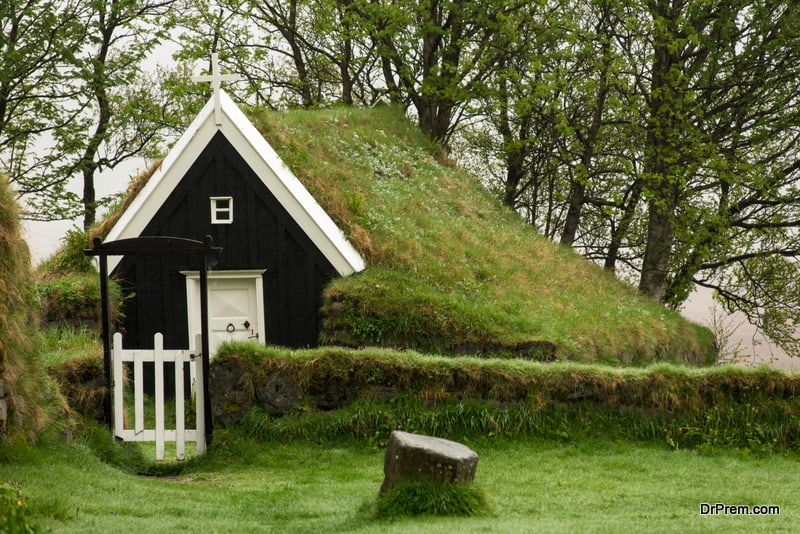Houses made inside thick stone or cave dwellings can be found in many parts of the world. Usually these cave houses were used for worshipping and gradually a whole new settlement took place around it. Gradually, over time, such cave towns ceased to exist and fell apart leaving behind hollow caves that we see today. However, still many parts of the world have such homes that have either been preserved or have been renovated for hotel and commercial purposes. Northern China still houses as many as 40 million people in cave houses, whereas Cappadocia in Turkey is known for its colorful cave-town covering the entire mountainous terrain.
Even these days, architects are getting fascinated with the idea of creating underground cave designs which are actually energy-saving homes as they require much lesser energy for cooling and heating and also do not require a lot of raw materials to construct. Furthermore, such houses do not disturb the natural surroundings of the landscape and therefore the greenery around the house is also maintained. However, here is a list of ten of the most impressive cave houses that still exist and function till date:
1. Guyaju is a great example of a network of cave houses that is located 57 miles away from Beijing, China. The origin of this 110 cave-room housing complex is unknown. However, it is the biggest one that has been found in China so far.
2. Even at present day, some local Berber inhabitants of a small Tunisian village called Matmata live in traditional underground cave or ‘troglodyte’ houses that have been built by forming huge pits and then converting them into rooms.
3. Bamiyan is another great example of cave dwellings located in central Afghanistan which has been in the news for the huge statues of Buddha that were bombed by the Taliban militants in 2001. The caves at the foot of the Buddha statues used to house more than a thousand monks and now these caves are being inhabited by the local civilians.
4. There is another amazing old cave town in Matera, south Italy called Sassi di Matera which actually means ‘stones of Matera’. This cave settlement is one of the first in Italy and dates to the prehistoric era. However, there are still some people who continue to live in this stone town just like their predecessors, although the Government is encouraging movement to the new city.
5. The 12th century cliff cave houses of the Native Americans called ‘Anasazi’ tribe in Mesa Verde, southwest Colorado, are one of the most important archaeological preserves in the US. Some of the cave houses have as many as 150 rooms. However, by 1300 most of the Anasazi had left the town for which historians have not found a valid reason. Nevertheless, their Mesa Verde cave township continues to be preserved.
6. In Mali, the Bandiagara Escarpment is a cliff made out of sandstone that reaches a height of 1,640 feet which is lined with many cave homes housing the Tellem people. These cave dwellings were built at a height so that the people would be able to escape the fury of floods and hence bury the dead at a height. These cliff cave towns are still inhabited by the Tellem people till date.
7. Vardzia is the name of a cave city and monastery that was built in the 12th century from a cliff in Georgia. This awe-inspiring architectural marvel was constructed to protect Queen Tamar from the Mongols. There is a housing complex that is 13 storeys high and has more than 600 apartments in it. Apart from this, the city had a well-built irrigation system that provided water to the farms, a throne hall and also a church. At present, Vardzia is occupied by monks and has become an affordable tourist spot.
8. Kandovan is a cave dwelling that was built in the 13th century and is located in East Azerbaijan Province in Iran. The shape of the cave dwelling is conical. Hence, the entire township looks like a termite colony.
9. Cappadocia in Goreme, Turkey is well-known for its cave-dwellings. Amongst all the Cappadocian towns, the most prominent is Ortahisar which is actually a castle that is built around the center of the structure. It was mainly used as a strategic location due to its high location at 86 meters.
10. Uçhisar is another such cave-castle located in Cappadocia which had the most number of inhabitants. However, due to the danger of erosion, the people migrated elsewhere. However, the topmost point of this castle offers a breathtaking panorama of the surroundings.
When we think about cave houses, we suddenly start imagining a damp, cold and uncomfortable place. However, that is not the case, as cave houses are being adopted by modern architects due to their eco-friendly qualities. Furthermore, with the right kind of interiors, a cave dwelling can be just as cozy, comfortable and elegant as any other house.




